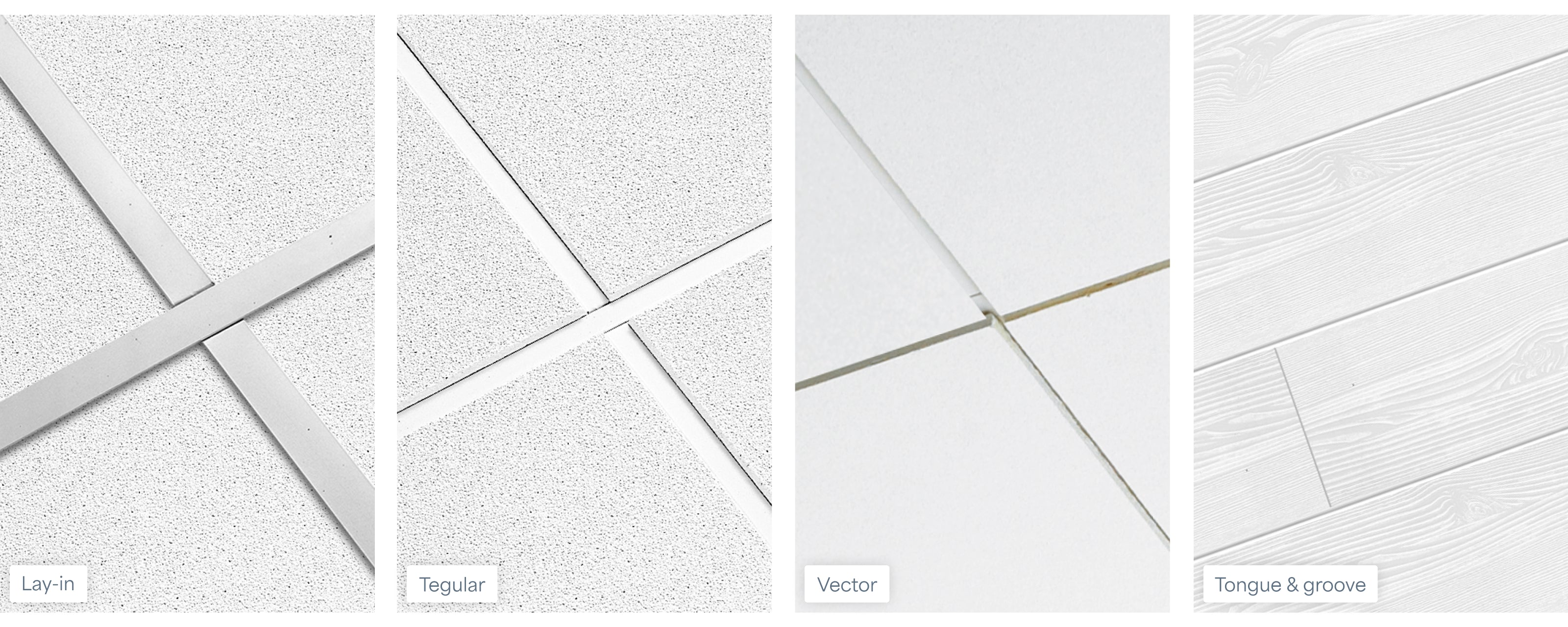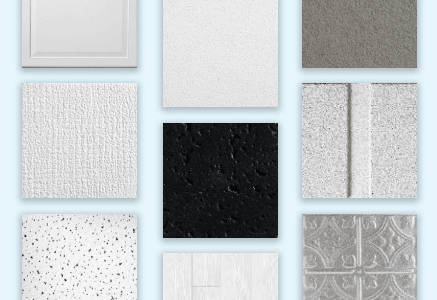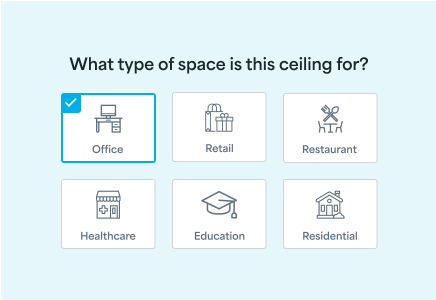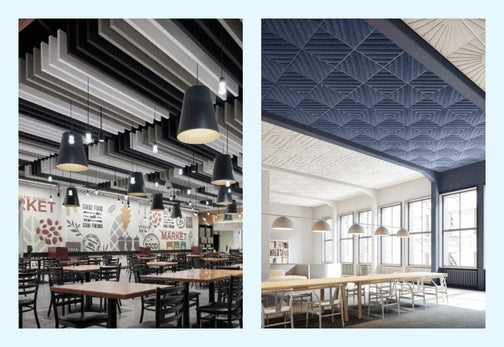4 Ceiling Tile Edge Types Explained

There are four main styles of ceiling tile edges; square, tegular, vector, and tongue and groove. How do you know which is compatible with your installation method and desired look? We’re here to help.
What is an edge profile?
The edge profile is the style or type of edge found on a ceiling tile. Some tiles are easier to install because of their edge type, while some minimize the amount of grid showing, and others offer design details to elevate your overall interior look.
Common edge profiles
- Square lay-in sits directly on the suspended ceiling grid.
- Square tegular hangs 1/4" below the grid creating a field of squares.
- Beveled tegular hangs 1/4" below the grid with rounded corners to create a softer look.
- Angled tegular hangs 1/4" below the grid with angled corners to create a softer look.
- Flush tegular hangs flush with the grid to create a smooth surface.
- Vector creates a clean, grid-hiding visual effect.
- Tongue & groove provides a seamless, uninterrupted grid-less look.
For more details, click here.
4 main ceiling tile edge types explained
Square lay-in
A square edge on an acoustical ceiling tile forms a rectangle when viewed from the side. Square Lay-in tiles are one of the simplest tiles to install and allow for easy access to pipes, wiring, and ducts.
Square edge tiles and panels sit flush with the suspension system, creating a classic, clean look. They come in a variety of sizes, colors, and textures making them great for large spaces like schools, mega stores, offices, and healthcare facilities.

Tegular
Tegular edge profiles are available in a variety of sizes and finishes and are often used to replace ceiling tiles for an updated, more modern look or used in new construction to create a visually pleasing final look.
A tegular edge refers to the stepped edge detail allowing a tile or panel to extend below the grid, making it less noticeable. A beveled tegular edge is the most common style and creates a soft look due to its angled or rounded step.
A few tiles have variations of the tegular edge. For example, in addition to a beveled tegular, CIRRUS Profiles, also offers a chamfered tegular (steps and angles) and a classic step tegular option.
It’s easy to update your tile style while maintaining easy access to all pipes, ducts, and wiring when you install a tegular edge tile.
Vector
A vector edge profile design provides downward accessibility and a clean upscale visual with a thin 1/4″ reveal, nearly hiding the grid. You can install vector edge tiles using a standard 15/16” suspended grid.
In this video, you'll learn about installation options and how to use perimeter trim, like AXIOM, to complete the vector ceiling look.
Tongue and groove
Tongue and groove edges are available on various tiles, but are most popular with surface mount applications like wood-look planks and GRENOBLE 12 x 12 ceiling tiles.
On one edge, you’ll see a groove running down the center side of the tile or plank and on the other, a corresponding tongue making each piece seamlessly fit together without a gap. They are easy to install and offer a modern, clean look.

All the ceiling tile edge profile variants
Now that you know the main edge types for ceiling tiles and how they look in the grid, have you decided on your ceiling style?
When shopping on Kanopi’s site, you’ll find illustrations of each option edge profile based on your tile and size. With multiple to choose from, you’re sure to find the desired look and functionality for your new ceiling!
Still can’t decide, try our ceiling selector to guide you to your perfect fit!
FAQ's
What are the different edge profile types of ceiling tiles?
There are various edge profiles available, but the most common ceiling tile edge profiles include Square Lay-in, Square Tegular, Angled Tegular, Beveled Tegular, Flush Tegular, Vector and Tongue & Groove. View the tile edge types and how they fit in a suspended ceiling grid. Edge Profile Details.
Can different edge profiles be mixed in the same ceiling installation?
While possible, it’s recommended to use the same edge profile for consistency in appearance.
How do edge profiles affect the ceiling installation process?
Different edge profiles may require specific grid systems or installation techniques. Square Lay-In edge ceiling tiles are the easiest to cut and install.
What is a beveled edge on a ceiling tile?
Beveled edges are characterized by a slight angle or bevel along the tile's edge; this profile offers a subtle transition between tiles. It adds a touch of sophistication to the ceiling and can help to disguise minor irregularities in the installation surface.
What is a tegular edge on a ceiling tile?
A tegular ceiling tile edge features a downward extension along the tile's perimeter. When installed, it creates a small reveal between the tiles, giving a three-dimensional look to the ceiling. Tegular edges are often used in spaces where a more detailed appearance is desired, such as in boardrooms or upscale residences.
Why are edges on ceiling tiles important?
Each edge profile offers its own unique aesthetic appeal and functional advantages. The choice of edge profile often depends on the design preferences, the architectural style of the space, and the desired visual impact. Edge profiles can also impact the acoustics of a room. Some profiles may have specific designs that aid in sound absorption or diffusion, contributing to the overall acoustic performance of the space.
What is a CIRRUS Profiles edge?
Armstrong’s CIRRUS Profiles ceiling tiles offer a unique, dimensional look in multiple styles. View the edge options for CIRRUS Profiles.



 Thanks for subscribing!
Thanks for subscribing!

